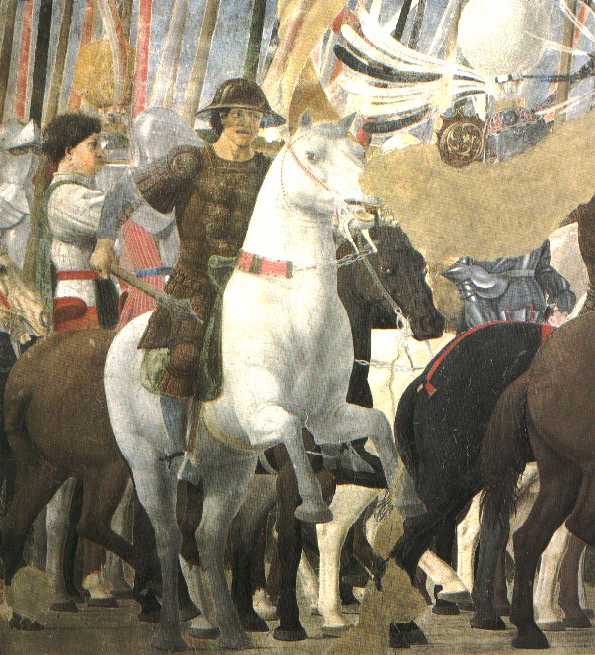The Victory of Constantine at the Battle of the Milvian Bridge, by Piero della Francesca, is part of a fresco cycle in the medieval church of St Francis in Arezzo.
The cycle depicts the story of the true cross, based on the 13th century Golden Legend of Jacopo da Varagine. Beginning with the death of Adam, the story describes how the wood of the cross on which Christ was crucified grew from a seed of the tree in the Garden of Eden. Adam's son Seth is instructed by the Archangel Michael to sow the seed in his dying father's mouth to save him from his original sin. Later, the Queen of Sheba, kneeling in adoration of the timbers of the holy tree that Solomon has used to build a bridge, predicted that the beams of this tree would form the cross on which Christ would die. Solomon then buried the wood, which was hidden until rediscovered by the Romans.
The dramatic climax of della Francesca's cycle is the depiction of the Battle of the Milvian Bridge on 28th October 312, during which the Emperor Constantine defeated his rival Maxentius. It is a key moment, not only in the legend but also in the history of Christianity. The previous evening, an angel had revealed in a vision the sign which would lead Constantine to victory the following day. Saying "In hoc signo vinces," the angel showed Constantine the cross. Della Francesca's stunning, although damaged, fresco creatively allies the historical aspects of the battle with contemporary themes. Constantine, leading his massed army with its upraised lances, holds out a small cross in his right hand in total confidence of his success.
His face is based on that of the former emperor of Byzantium, John VIII Palaeologus (1425 - 1448). It is no coincidence that at the time the frescoes were painted (in two stages, firstly from 1458 to 1459, with completion in 1466), Pope Pius II was planning a new crusade against the Turks. The fresco is not simply a reminder of the greatest Christian victory of the past, but an encouragement to renew those victories. Maxentius, Constantine's enemy, drowns in the Tiber, thus avoiding bloodshed between emperors. The cool, fresh, almost rain-washed colours leave an impression of timelessness, befitting the legendary nature of the theme.




